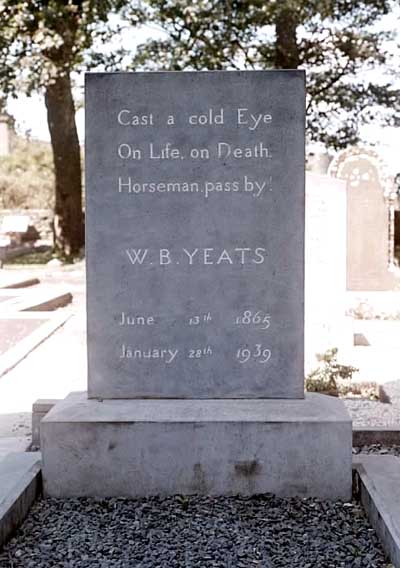O would, beloved, that you layUnder the dock-leaves in the ground,While lights were paling one by one.
Thus spoke the great Irish poet, William Butler Yeats, who would die in France in 1939. He lived during a tumultuous time in Ireland's history, and recorded his impressions of the Easter Rising of 1916 in poetry that lives on.
He was highly acclaimed in his day, and asked his wife to plant him in French soil for a year or so, until all the buzz died down about his passing. Then she was to dig him up and bring him home to Sligo, where he could rest in peace and have a peaceful burial as well.
When you're dying, it's no easy task to hold off the inevitable end, even if the world is plunging into war and your last request is going to have to be delayed. Hitler started doing his invading and by 1940, there was no disinterring dead Irish poets for transport out of France. The French had plenty of other things to worry about, and Mr. Yeats' desire to have his final resting place in his homeland was not a priority.
After the war, Mrs. Yeats thought that she would honor her late husband's wish, but nine years post-mortem, there would be nothing but dust and bones to be dug up. She wanted it done just the same, and the orders came down from the authorities.
 |
| W. B. Yeats et al. |
Except, you see, there was this demand for burial space in the French cemetery. So many young men to be interred, to say nothing of the normal contingent of corpses, and room must always be made for the next batch. It is not uncommon for bones of the deceased to be dug up and stored in an ossuary, a sort of warehouse for the last bits. A final resting place in Europe is not always final, unless you are wealthy or very important. No one is emptying the sarcophagi in The Pantheon, now, are they, but some Irish poet underground? Make room for the next one, out you go William Butler.
But Mrs. Yeats was not to be deterred, so the French in charge asked the local coroner to put together a skeleton with whatever parts he might find that could have come from W. B. Yeats. The man had a large head, so a big skull was selected. He wore a truss due to a hernia, so they found some hip bones that were entangled in a medical device. Close enough, right, and a nice box of bones was shipped back to Sligo.
No one said a word about the lack of authenticity. Ireland wanted to bury one of its heroes, and that was all that mattered. Just because some of the bones might have belonged to a British gentleman who was buried next to Mr. Yeats did not matter, except to that gentleman's family. A flurry of letters followed, the heated exchange kept largely from the public because, well, Ireland in 1948.....
So who is buried in Yeats' tomb in Sligo?
Not Mr. Yeats. Perhaps pieces of him, but the rest of the bones are a miscellaneous gathering of body parts. Papers recently turned over to Ireland by France explain the whole sordid mess, and the cover-up that followed. What makes the matter particularly pertinent is the fact that Prince Charles and his consort Camilla paid their respects at Yeats' grave recently, so it would appear that they paid their respects to the remains of several others, all of whom shared the communal grave with the famous poet.
Once you're dead, though, does it really matter where your bones are lodged? You'd be more concerned with where your soul is heading.
No comments:
Post a Comment